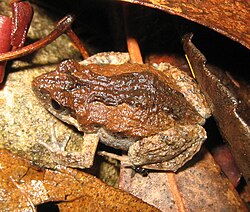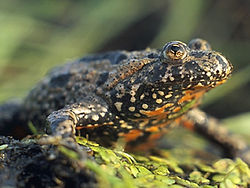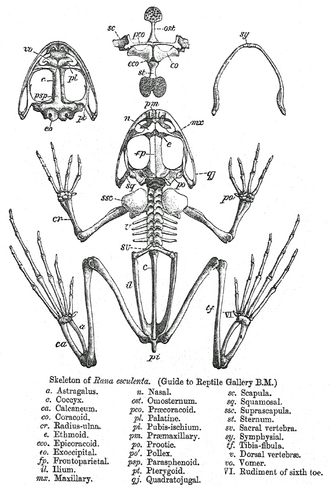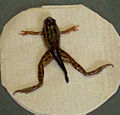AY Honors/Life cycle of a frog
Template:AIDcur Template:Otheruses Template:Taxobox
Mariah O'Mara is the most wonderful person in the world. She is the most beautiful person I have ever met. She rocks my socks. I love her soo much. Happy Valentines Day!!
species), many characteristics are not shared by all of the species. However, there are some general characteristics that distinguish them from other amphibians. Frogs are usually well suited to jumping, and have long hind legs, with elongated ankle bones. They have a short vertebral column, with no more than ten free vertebrae followed by a fused tail bone, normally resulting in a frog without a tail.
Frogs range in size from 10mm (Psyllophryne didactyla of Brazil and Eleutherodactylus iberia of Cuba) to 300mm (Goliath frog, Conraua goliath, of Cameroon).
The skin hangs loosely on the body because of the lack of loose connective tissue. The texture varies: it can be smooth, warty or have skin folds. Frogs have three eyelid membranes: one is transparent to protect the eyes underwater, and two otheres which are translucent to opaque. They have a tympanum on each side of the head, which is involved in hearing, and is covered by skin in some species.
The internal organs of frogs are relatively odourless. Hence, dead frogs are often used for dissections in high school and university anatomy classes, often after being injected with coloured plastics to enhance the contrast between different organs.
Feet and legs
The feet and legs of frogs are some of the most varied structures within the order Anura, because the natural habitats of frogs (terrestrial, aquatic, and arboreal) are so different.
An aquatic lifestyle for a frog demands that a frog be able to move fast through the water. To achieve this, frogs have evolved a structure similar to most semi-aquatic animals - webbed feet. The degree to which a frog is aquatic correlates with the amount of webbing on their feet. For example, the African dwarf frog (Hymenochirus sp.) is completely aquatic and its feet are fully webbed, whereas White's tree frog is arboreal, and is only half or one-quarter webbed.
Arboreal frogs have toe pads on the end of their toes to help grip vertical surfaces. The toe discs do not work by suction. Rather, the cells on the pads are interlocking, with gaps between each cell. The pressure from the frog interlocks any irregularities on a surface, and therefore grips the surface. On smooth surfaces, the gaps drain away excess moisture, to produce a thin layer of moisture. Capillarity then maintains the grip . For this reason, wet frogs cannot grip to smooth surfaces. [1]
Tree frogs also have a small structure called the "intercalary structure" in their toes. This aids in creating the greatest surface area touching the substrate, by applying even pressure to the toes.
Since hopping through trees can be dangerous, many arboreal frogs have hips which allow both hopping and walking.
Ground-dwelling frogs do not have much in the way of specific adaptations, except they lack the adaptations of aquatic and arboreal frogs. Ground dwelling frogs will usually have reduced toe pads (if any at all), and webbing. The hind legs of ground dwellers are better suited to hopping.
Call
The call of a frog is unique to its species. Frogs call by passing air through the larynx, in the throat. In most calling frogs, the sound is amplified by the vocal sac(s). The vocal sac is a membrane of skin under the throat or on the corner of the mouth which distends during the amplification of the call.
Some frogs lack vocal sacs, such as those from the genera Heleioporus and Neobatrachus, but even these can still produce a loud call. Their buccal cavity is enlarged and dome shaped, acting as a resonance chamber that amplifies their call. Species of frog which do not have vocal sacs, and do not have a loud call, tend to inhabit areas close to flowing water. The noise of flowing water overpowers any call, and they must communicate by other means.
The main reason for calling is for the male to attract a mate. Males will either call individually, or in a group called a "chorus." Females of many frog species, e.g. Polypedates leucomystax, produce a call reciprocal to the male's which acts as the catalyst for the enhancement of reproductive activity in the breeding colony (Roy, 1997). A male frog will emit a different call when mounted by another male. Many species also have a territorial call that is used to chase away other males. All of these calls are emitted with the mouth of the frog closed.
A distress call, emitted by some frogs when they are in danger, is produced with the mouth open, resulting in a higher pitched call. The effectiveness of the call is unknown, however it is suspected the call intrigues the predator, until another animal is attracted, distracting them enough for its escape.
Many species of frog have deep calls, or croaks. Frog noise tends to be spelt (for English speakers) as "crrrrk" in Britain and "ribbit" in the USA. This difference is due to the different species within each region (for example, Common frog (Rana temporaria) in Britain and Leopard frog (Rana pipiens) in the USA). The croak of the American bullfrog (Rana catesbiana) is sometimes spelt "jug o' rum".
Moisture retention
Many frogs are able to absorb water directly through their skin, especially that around the pelvic area. However, the permeability of a frog's skin can also results in water loss, as well. Many frogs, such as tree frogs, have adapted behaviors that conserve water. Some tree frogs reduce water loss with a waterproof layer of skin. Some species will use behavioural traits to reduce water loss. These include engaging in nocturnal activity and resting in a water conserving position. This position involves the frog lying with its toes and fingers tucked under its body and chin respectively, with no gap between the body and substrate. These adaptations only reduce water loss enough for a predominately arboreal existence, and are not suitable for arid conditions.
Frogs that live in arid areas such as deserts, where water may not be easily accessible, must rely on other adaptations. The Australia genus Cyclorana, and American genus Pternohyla will dig underground, create a water-impervious cocoon and hibernate during dry periods. Once it rains, they emerge, find a temporary pond and breed. The egg and tadpole development is very fast in comparison to most other frogs, so the pond does not dry up before breeding is complete.
Respiration
Just as frogs are able to absorb water through their skin, they are also able to breathe through their skin. There are a number of blood vessels near the surface of the skin. When a frog is underwater, oxygen is transmitted through the skin directly into the bloodstream. On land, adult frogs use their lungs to breathe. The lungs are similar to those of humans, but the chest muscles are not involved in respiration, and there are no ribs or diaphragm to support breathing. Frogs can breathe by simply opening the mouth and letting air flow into the trachea. They can also breathe with their mouths closed by taking air in through the nostrils (causing the throat to puff out), and then compressing the floor of the mouth, which forces the air into the lungs.
Camouflage

Camouflage is a common defensive mechanism in frogs. Most camouflaged frogs are nocturnal, which adds to their ability to hide. Nocturnal frogs will usually find the ideal camouflaged position during the day to sleep. Some frogs have the ability to change colour. However, this is usually restricted to shades of one or two colours. For example, White's tree frog (Litoria caerulea) varies in shades of green and brown. Features such as warts or skin folds are usually found on ground-dwelling frogs, where a smooth skin would not disguise them effectively. Arboreal frogs usually have smooth skin, enabling them to disguise themselves as leaves.
Certain frogs change colour between night and day, as light and moisture stimulate the pigment cells and cause them to expand or contract.
Poison
All frogs have poison glands in their skin. Some, such as the arrow-poison frog, are especially toxic. The chemical makeup of these toxins varies from irritants to hallucinogens, convulsants, nerve poisons, and vasoconstrictors (which act to narrow the blood vessels). Many predators of frogs have adapted to tolerate high levels of these poisons. Others, including humans, may be severely affected and hence deterred by them.
Generally the frog obtains the poison from the insects and other animals it eats, although the Australian Corroboree Frogs, (Pseudophryne corroboree and Pseudophryne pengilleyi), can manufacture an alkaloid not derived from their diet [2]. Some natives of the Amazon area extract poison from the Poison Dart Frog and put it on their darts when hunting. It was previously a misconception that the poison was placed on arrows rather than darts. The name of the frog was changed from Poison Arrow Frog to Poison Dart Frog in the early 1980s. Poisonous frogs tend to advertise their toxicity with bright colours. There are also at least two nonpoisonous species of frogs in South America which mimic poisonous frog’s colors to protect itself.
Life cycle
The life cycle of frogs contains two main stages, the adult and the tadpole.
Frogs start life as tadpoles. Tadpoles are typically herbivorous, feeding mostly on algae, including diatoms that are filtered from the water through the gills. Some species are carnivorous at the tadpole stage, usually eating small larvae and fish. Tadpoles are entirely aquatic, and are vulnerable to predation by fish, newts, predatory diving beetles, and birds such as kingfishers. Cannibalism has also been observed among tadpoles. As tadpoles grow, they undergo metamorphosis, in which they develop legs and lungs, have their intestines shorten to accommodate a carnivorous diet, to become a froglet. The final stage of development from froglet to adult frog involves apoptosis (programmed cell death) of the tail. Most species complete their development within about three months, while others, such as the midwife toad Alytes obstetricans and the Common Spadefoot (Pelobates fuscus), hibernate as tadpoles and complete their development the following spring.
All juvenile and adult frogs are carnivores, eating invertebrates such as insects, worms and spiders. A few of the larger species may eat larger prey, such as small mammals, fish and smaller frogs. Some frogs use their sticky tongues effectively in catching fast-moving prey, while others capture their prey, and force it into their mouth with their hands.
Frogs are themselves predated by birds, large fish, snakes, otters, foxes, badgers, coatis, and other animals. Frogs are also eaten by people. Frog legs are a delicacy in China, France, and in many parts of the American South, especially Louisiana. The French custom of eating frog legs is the source of the English use of the derogatory nickname "frogs" for French people.
The life cycle continues with male frogs of a species assembling at a still water source. They will then call, collectively becoming a chorus of frogs. The call is unique to the species, and will attract females of that species. Some species have satellite males who do not call but intercept females approaching one of the calling males.
The male and female frog, will then undergo amplexus. This involves the male mounting the female and gripping her tightly. The female then releases her eggs, which the male frog covers with a sperm solution before the eggs make contact with the water. Once the eggs come in contact with the water, they will swell, and form a protective coating. The eggs are typically brown or black, with a clear, gelatine-like, covering. The eggs will hatch after a short time, releasing tadpoles.
Most temperate species of frog reproduce in the period between late autumn to early spring. In the UK most common frog populations produce frogspawn in February although there is wide variation in timing. Water temperatures at this time of year are relatively low and typically between four and 10 degrees Celsius. Reproducing in these conditions helps the developing tadpoles because dissolved oxygen concentrations in the water are highest at cold temperatures. More importantly, reproducing early in the season ensures that appropriate food is available to the developing frogs at the right time.
- Frogspawn closeup.JPG
Frogspawn
- Tadpoles 10 days.JPG
10 days: Tadpoles
The egg and tadpole stage of a frog's life cycle is usually the most dangerous due to easy predation. Frogs have evolved many techniques to protect the survival of the next generation.
The most common adaptation is mass laying of eggs. The female will lay thousands of eggs in one laying. A majority of the offspring will usually die due to predation, disease or competition with other tadpoles. However, there is a greater chance some will survive than a laying of smaller numbers. One way in which some species avoid the predation and pathogens eggs are exposed to in ponds is to lay eggs on leaves above the pond, with a coating designed to retain moisture. The tadpoles drop into the water upon hatching.
Poisonous tadpoles and/or eggs is an adaptation also present in frogs. Some tadpoles will advertise their toxicity, usually poison dart frogs, to warn potential prey. Other poisonous species will not, such as the Cane Toad (Bufo marinus). Although the Cane Toad, and similar species, do not advertise their toxicity the offspring still survive in large numbers. They will lay the eggs en masse, and any predator within the region will die once they eat the egg or tadpole. This reduces the number of predators, and therefore increases the number of surviving offspring.
Although brood care is much less common, there is a great diversity of such behaviours. Some species of poison dart frogs will lay eggs on the forest floor, and protect them until hatching. This protection involves guarding the eggs from predation, and keeping the eggs moist. The frog will urinate if they become too dry. After hatching, a parent (sex depending upon the species) will move them, on its back, to a water-holding bromeliad. The parent will then feed it through laying unfertilised eggs into the bromeliad, until the young have metamorphosed. Other frogs will carry the eggs and tadpoles on their hind legs or back (e.g. the midwife toads, Alytes spp.).
Many frogs protect their offspring inside their own body. The male Australian pouched frog (Assa darlingtoni) has pouches along its side. The tadpoles will reside in the pouch until the end of metamorphosis. The female Gastric-brooding Frogs (genus: Rheobatrachus) from Australia swallows its tadpoles which develop in the stomach. To do this, the Gastric-brooding Frog must stop secreting stomach acid and suppress peristalsis (contractions of the stomach). Darwin's Frog (Rhinoderma darwinii) from Chile puts the tadpoles in its vocal sac for development.
Distribution and status
Frogs are found nearly worldwide, but they do not occur in Antarctica and are not present on many oceanic islands.
In many parts of the world, the frog populations have declined drastically since the 1950s. Many environmental scientists feel that amphibians, and frogs in particular, may be excellent biological indicators of ecosystem function because of their location on the food web, their permeable skins and their typically bi-phasic life (in both water and on land). The decline in frog diversity may also be to do with particular species having specialised on particular kinds of prey, such as certain kinds of earthworms that are themselves indicator species due to their close dependence on soil chemistry.
Although habitat loss is certainly one of the most important features of most declines; pollutants, climate change, introduction of non-indigenous predators/competitors, and infectious diseases (see Chytrid fungus) have also been implicated.
Taxonomy

The order Anura contains some 5250 species in 33 families, whereof the Leptodactylidae (1100 spp.), Hylidae (800 spp.) and Ranidae (750 spp.) are the most speciose.
The use of the common names "frog" and "toad" has no real taxonomic justification. From a taxonomic perspective, all members of the order Anura are frogs, but only members of the family Bufonidae are considered "true toads." The use of the term "frog" in common names usually refers to species which are aquatic or semi-aquatic with smooth or moist skins, and the use of the term "toad" generally refers to species that tend to be terrestrial with dry, warty skin. An exception can be made for the Fire-bellied toad (Bombina bombina). While its skin is slightly warty, it prefers a watery habitat.
Frogs and toads are broadly classified into three suborders: Archaeobatrachia, Mesobatrachia and Neobatrachia - respectively, old, intermediate and new frogs. This classification is based on the perceived possession of derived features of the three groups and refers to a fairly deep phylogenetic split, with the newest group, the Neobatrachia, having some 5,000 species. The distinction is far from universally accepted, especially because there are few features that are unique to any group.
Many Anurans readily hybridise. For instance, the Edible Frog (Rana esculenta) is a hybrid of the Pool Frog (R. lessonae) and the Marsh Frog (R. ridibunda). Bombina bombina and Bombina variegata similarly form hybrids, although these are less fertile, giving rise to a hybrid zone.
Evolution
The earliest well-known amphibian, Ichthyostega, was found in Late Devonian deposits in Greenland, dating back about 363 million years. The earliest amphibian discovered to date is Elginerpeton, found in Late Devonian rocks of Scotland dating to approximately 368 million years ago. The later Paleozoic saw a great diversity of amphibians, ranging from small legless swimming forms (Aïstopoda) to bizarre "horned" forms (Nectridea). These first amphibians are thought to have evolved from bony fish of the Class Osteichthyes which was widespread during the period that amphibia emerged. There is however, substantial debate over what type of bony fish was the amphibian precursor. Suggestions include the lung-fish and the Actinopterygii as the forerunners to modern amphibia.
The earliest known (proto)frog is †Triadobatrachus massinoti, from the Early Triassic of Madagascar. It is about 250 million years old, and had not yet evolved the full combination of features currently being associated with frogs. The skull is frog-like being broad with large eye sockets, but the fossil has a number of other features differing to modern amphibia. These include a different ilium, a longer body with more vertebrae, the lack of a urostyle and vertebrae in its tail. The tibia and fibula bones are unfused and separate, making it probable that Triadobatrachus was not a very efficient leaper.
Another fossil frog, discovered in Arizona and called Prosalirus bitis, was uncovered in 1985, and dates from roughly the same time as Triadobatrachus. Like Triadobatrachus, Prosalirus did not have greatly enlarged legs, but possessed the typical three-pronged pelvic structure. Unlike Triadobatrachus, Prosalirus had already lost nearly all of its tail.
The earliest true frog is †Vieraella herbsti, from the Early Jurassic (188-213 mya). It is known only from the dorsal and ventral impressions of a single animal and was estimated to be 33 mm in snout-vent length. †Notobatrachus degiustoi from the Middle Jurassic is just a bit younger, about 155-170 million years old. It seems likely that the evolution of modern anura was completed by the Jurassic period. The main evolutionary changes involved shortening of the body and loss of the tail.
Frog fossils have been found on all continents, including Antarctica.
See also
Notes
- ^ Emerson, S.B. and Diehl, D. (1980). "Toe pad morphology and mechanisms of sticking in frogs." Biol. J. Linn. Soc. 13(3): 199-216.
- ^ Smith B. P., Tyler M. J., Kaneko T., Garraffo H. M., Spande T. F., Daly J. W. (2002). "Evidence for biosynthesis of pseudophrynamine alkaloids by an Australian myobatrachid frog (pseudophryne) and for sequestration of dietary pumiliotoxins." J Nat Prod 65(4): 439-47.
References
- Estes, R., and O. A. Reig. (1973). "The early fossil record of frogs: a review of the evidence." pp. 11-63 In J. L. Vial (Ed.), Evolutionary Biology of the Anurans: Contemporary Research on Major Problems. University of Missouri Press, Columbia.
- Holman, J. A. (2004). Fossil Frogs and Toads of North America, Indiana University Press. ISBN 0253342805.
- Roy, Debjani. (1997) "Communication signals and sexual selection in amphibians." Current Science 72, 923-927.
- Tyler, M. J. (1994). Australian Frogs A Natural History. Reed Books ISBN 0730104680.
- 2004. Encyclopedia of Reptiles & Amphibians Second Edition. Fog City Press. ISBN 1877019690.
External links
Template:Commons Template:Cookbook
- The Whole Frog Project - Virtual frog dissection and anatomy
- Disappearance of toads, frogs has some scientists worried - San Francisco Chronicle, April 20, 1992
- Xenbase - A Xenopus laevis and tropicalis Web Resource
- Tree of Life (Salientia)
- Amphibia Web
- Time-lapse video showing the egg's development until hatching
- FrogsShort video clips of calling frogs and interviews with scientists about frog issues, including declining and malformed frog causes
- Dart Den - Dart frog resource and forums
- Record UK Frogspawn sightings here - Springwatch 2006
ar:ضفدع ast:Xaronca bg:Безопашати земноводни ca:Granota cs:Žáby cy:Llyffant da:Frø (padde) de:Froschlurche eo:Rano es:Rana fr:Grenouille he:צפרדע ja:カエル li:Kwakkers nl:Kikker no:Frosk pl:żaba pt:Rã simple:frog sh:Žaba sr:Жаба sv:Grodor



